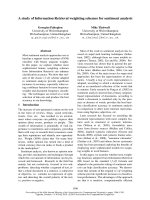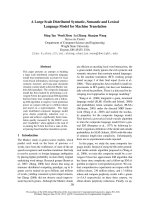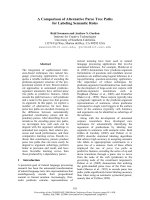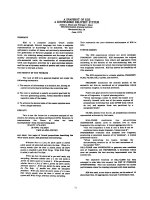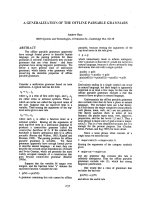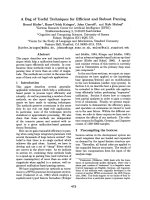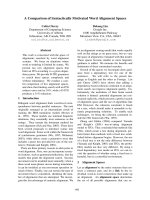Báo cáo khoa học: "A Model of Early Syntactic Development" docx
Bạn đang xem bản rút gọn của tài liệu. Xem và tải ngay bản đầy đủ của tài liệu tại đây (812.43 KB, 7 trang )
A Model of Early Syntactic Development
Pat
Langley
The Robotics Institute
Carnegie-Mellon University
Pittsburgh, Pennsylvania 1521,3 USA
ABSTRACT
AMBER is a model of first language acquisition that improves its
performance through a process of error recovery. The model is
implemented as an adaptive production system that introduces
new condition-action rules on the basis of experience. AMBER
starts with the ability to say only one word at a time, but adds
rules for ordering goals and producing grammatical morphemes,
based on comparisons between predicted and observed
sentences. The morpheme rules may be overly general and lead
to errors of commission; such errors evoke a discrimination
process, producing more conservative rules with additional
conditions. The system's performance improves gradually, since
rules must be relearned many times before they are used.
AMBER'S learning mechanisms account for some of the major
developments observed in children's early speech.
1.
Introduction
In this paper, I present a model that attempts to explain the
regularities in children's early syntactic development. The model
is called AMBER, an acronym for Acquisition Model Based on
Error Recovery. As its name implies, AMBER learns language by
comparing its own utterances to those of adults and attempting
to correct any errors. The model is implemented as an adaptive
production system - a formalism well-suited to modeling the
incremental nature of human learning. AMEER focuses on issues
such as the omission of content words, the
occurrence
of
telegraphic speech, and the order in which function words are
mastered. Before considering AMBER in detail, I will first review
some major features of child language, and discuss some earlier
models of these phenomena.
Children do not learn language in an all.or.none fashion. They
begin their linguistic careers uttering one word at a time, and
slowly evolve through a number of stages, each containing more
adult-like speech than the one before. Around the age of one
year, the child begins to produce words in isolation, and
continues this strategy for some months. At approximately 18
months, the child begins to combine words into meaningful
sequences. In order-based languages such as English, the child
usually follows the adult order. Initially only pairs of words are
produced, but these are followed by three-word and later by
four-word utterances. The simple sentences occurring in this
stage consist almost entirely of content words, while
grammatical morphemes such as tense endings and prepositions
are largely absent.
During the period from about 24 to 40 months, the child
masters the grammatical morphemes which were absent during
the previous stage. These "function words" are learned
gradually; the time between the initial production of a morpheme
and its mastery may be as long as 16 months. Brown (1973) has
examined the order in which 14 English morphemes are
acquired, finding the
order
of acquisition to be remarkably
consistent across children. In addition, those morphemes with
simpler meanings and involved in fewer transformations are
learned earlier than more complex ones. These findings place
some strong constraints on the learning mechanisms one
postulates for morpheme acquisition.
Now that we have reviewed some of the major aspects of child
language, let us consider the earlier attempts at modeling these
phenomena. Computer programs that learn language can be
usefully divided into two groups: those which take advantage of
semantic feedback, and those which do not. In general, the early
work concerned itself with learning grammars in the absence of
information about the meaning of sentences. Examples of this
approach can be found in Solomonoff (1959), Feldman (1969)
and Homing (1969). Since children almost certainly have
semantic information available to them, I will not focus on their
research here. However, much of the early work is interesting in
its own right, and some excellent systems along these lines have
recently been produced by Berwick (1980) and Wolff (1980).
In the late 1960's, some researchers began to incorporate
semantic information into their language learning systems. The
majority of the resulting programs showed little concern with the
observed phenomena, including Siklossy's ZBIE (1972), Ktein's
AUTOLING (1973), Hedrick's production system model (1976),
Anderson's LAS (1977), and Sembugamoorthy's PLAS (1979).
These systems failed as models of human language acquisition
in two major areas. First, they learned language in an all-or.none
manner, and much too rapidly to provide useful models of child
language. Second, these systems employed conservative
learning strategies in the hope of avoiding errors. In contrast,
children themselves make many errors in their early
constructions, but eventually recover from them.
However, a few researchers have attempted to construct
plausible models of the child's learning process. For example,
Kelley (1967) has described an "hypothesis testing" model that
learned successively more complex phrase structure grammars
for parsing simple sentences. As new syntactic classes became
available, the program rejected its current grammar in favor of a
more accurate one. Thus, the model moved from a stage in
which individual words were viewed as "things" to the more
sophisticated view that "subjects" precede "actions". One
drawback of the model was that it could not learn new categories
on its own initiative; instead, the author was forced to introduce
them manually.
Reeker (1976) has described PST, another theory of early
syntactic development. This model assumed that children have
limited short term memories, so that they store onty portions of
an adult sample sentence. The model compared this reduced
sentence to an internally generated utterance, and differences
145
between the two were noted. Six types of differences were
recognized (missing prefixes, missing suffixes, missing infixes,
substitutions, extra words, and transpositions), and each led to
an associated alteration of the grammar. PST accounted for
children's omission of content words and the gradual increase in
utterance length. The limited memory hypothesis also explained
the telegraphic nature of early speech, though Reeker did
not
address the issue of function word acquisition. Overgeneral-
izations did occur in PST, but the model could revise its grammar
upon their discovery, so as to avoid similar errors in the future.
PST also helped account for the incremental nature of language
acquisition, since differences were addressed one at a time and
the
grammar changed only slowly.
Selfridge (1981) has described CHILD, another program that
attempted to explain some of the basic phenomena of first
language acquisition. This system began by learning the
meanings of words in terms of a conceptual dependency
representation. Word meanings were initially overly specific, but
were generalized as more examples were encountered. As more
words were learned and their definitions became less restrictive,
the length of CHILD'S utterances increased. CHILD differed from
other models of language learning by incorporating, a non-
linguistic component. This enabled the system to
correctly
respond to adult sentences such as Put the ba/I in the box,
and
led to the appearance that the system understood language
before it could produce it. Of course, this strategy sometimes led
to errors in comprehension. Coupled with the disapproval of a
tutor, such errors were one of the major spurs to the learning of
word orders. Syntactic knowledge was stored with the meanings
of words, so that the acquisition of syntax necessarily occurred
after the acquisition of individual words.
Although tl~ese systems fare much better as psychological
models than other language learning programs, they have some
important limitations. We have seen that Kelley's system required
syntactic classes to be introduced by hand, making his
explanation less than satisfactory. Selfridge's CHILD was much
more robust than Kelley's program, and was unique in modeling
children's use of nonlinguistic cues for understanding. However,
CHILD'S
explanation for the omission of content words - that
those words are not yet known - was implausible, since children
often omit words that they have used in previous utterances.
Reeker's PST explained this phenomenon through a limited
memory hypothesis, which is consistent with our knowledge of
children's memory skills. Still, PST included no model of the
process through which memory improved; in order to simulate
the acquisition of longer constructions, Reeker would have had
to increase the system's memory size by hand. Both CHILD and
PST learned relatively slowly, and made mistakes of the general
type observed with children. Both systems addressed the issue
of error recovery, starting off as abominable language users, but
getting progressively better with time. This is a promising
approach that I' attempt to develop it in its extreme form in the
following pages.
2.
An Overview of AMBER
Although Reeker's PST and Selfridge's CHILD address the
transition from one-word to multi-word utterances, we have seen
that problems exist with both accounts. Neither of these
programs focus on the acquisition of function words, their
explanations of content word omissions leave something to be
desired, and though they learn more slowly than other systems,
they still learn more rapidly than children. In response to these
limitations, the goals of the current research are:
• Account for the omission of content" words, and the
eventual recovery from such omissions.
• Account for the omission of function words, and the order in
which these morphemes are mastered.
• Account for the gradual nature of both these linguistic
developments.
In this section I provide an overview of AMBER, a model that
provides one set of answers to these questions. Since more is
known about children's utterances than their ability to
understand the utterances of others, AMBER models the learning
of generation strategies, rather than strategies for understanding
language.
Selfridge's and Reeker's models differ from other language
learning systems in their concern with the problem of recovering
from errors. The current research extends this idea even further,
since all of AMBER'S learning strategies operate through a
process of error recovery. 1 The model is presented with three
pieces of information: a legal sentence, an event to be
described, and a main goal or topic of the sentence. An event is
represented as a semantic network, using relations like agent,
action, object, size, color, and type. The specification of one of
the nodes as the main topic allows the system to restate the
network as a tree structure, and it is from this tree that AMBER
generates a sentence. If this sentence is identical to the sample
sentence, no learning is required. If a disagreement between the
two sentences is found, AMBER modifies its set of rules in an
attempt to avoid similar errors in the future, and the system
moves on to the next example.
AMBER'S performance system is stated as a set of condition-
action rules or productions that operate upon the goal tree to
produce utterances. Although the model starts with the potential
for producing (unordered) telegraphic sentences, it can initially
generate only one word at a time. To see why this occurs, we
must consider the three productions that make up AMBER'S initial
performance system. The first rule (the start rul~) is responsible
for establishing subgoals; it may be paraphrased as:
START
If you want to describe node1,
and node2 is in relation to node1,
then describe
node2.
Matching first against the main goal node, this rule selects one of
the nodes below it in the tree and creates a subgoal to describe
that node. This rule continues to establish lower level goals until
1 In spirit, AMBER is very similar to Reeker's model, though they
differ in many details. Historically, PST had no impact on the
development of AMBER. The initial plans for AMBER arose from
discussions with John R Anderson in the fall of 1979, while I did
not become aware of Reeker's work until the fall of 1980.
2For the sake of clarity, I will be presenting only English
paraphrases of the actual PRISM productions. All variables are
italicized; these may match against any symbol, but all
occurrences of a variable -" ~'. ~,~atch to the same element.
146
a terminal node is reached. At this point, a second production
(the
speak
rule) is matched; this rule may be
stated:
SPEAK
If
you want to describe
a
conceptt
and
word
is
the word for
concept,
then say
word
and note
that
concept
has been described.
This production retrieves the word for the concept AMBER wants
to describe, actually says this word, and marks the terminal goal
as satisfied. Once this has been done, the third and final
performance production becomes true. This rule matches
whenever a subgoal has been satisfied, and attempts to mark the
supergoal as satisfied; it may be paraphrased as:
STOP
If you want to describe
node1,
and
node2
is in
re/ation
to
nodel,
and
node2
has already
been described,
then note
that
node1
has been described.
Since the
stop
rule is stronger 3 than the
start
rule (which would
like to create another subgoal), it moves back up the tree,
marking each of the active goals as satisfied (including the main
goal). As a result, AMBER believes it has successfully described
an event after it has uttered only a single word. Thus, although
the model starts with the potential for producing multi.word
utterances, it must learn additional rules (and make them
stronger than the
stop
rule) before it can generate multiple
content words in the correct order.
In general, AMBER learns by comparing adult sentences to the
sentences it would produce in the same situations. These
predictions reveal two types of mistakes - errors of
omission
and errors of
commission.
These errors are detected by
additional/earning productions that are responsible for creating
new performance rules. Thus, AMBER is an example of what
Waterman (1975) has called an
adaptive production system,
which modifies its own behavior by inserting new condition-
action rules. Below I discuss AMBER'S response to errors of
omission, since these are the first to occur and thus lead to
the
system's first steps beyond the one-word stage. I consider the
omission of content words first, and then the omission of
grammatical morphemes. Finally, I discuss the importance of
errors of commission in discovering conditions on the
production of morphemes.
3.
Learning Preferences and Orders
AMBER'S initial self-modifications result from tile failure to
predict content words. Given its initial ability to say one word at
a time, the system can make two types of content word
omissions - it can fail to predict a word
before
a correctly
predicted one, or it can omit a word
after
a correctly predicted
one. Rather different rules are created in each case. For
example, imagine that Daddy is bouncing a ball, and suppose
that AMBEa predicted only the word "ball", while hearing the
sentence "Daddy is bounce ing the ball". In this case, one of the
system's learning rules would note the omitted content word
3The notion of strength plays an important role in AMBER'S
explanation of language learning. When a new rule is created, it
is given a low initial strength, but this is increased whenever that
rule is relearned. And since stronger productions are preferred
to their weaker competitors, rules that have been learned many
times determine behavior.
"Daddy" before the content word "ball", and an agent
production would be created:
AGENT
If you want to describe
event1,
and
agent1
is the agent of
event1,
then
desc ribe
agent1.
Although I do not have the space to describe the responsible
learning rule in detail, I can say that it matches against situations
in which one content word is omitted before another, and that it
always constructs new productions with the same form as the
agent
rule described above. In this case, it would also create a
similar rule for describing actions, based on the omitted
"bounce". Note that these new productions do
not
give AMBER
the ability to say more than one word at a time. They merely
increase the likelihood that the program will describe the agent
or action of an event instead of the object.
However, as AMBER begins to prefer agents to actions and
actions to objects, the probability of the second type of error
(omitting a word after a correctly predicted one) increases. For
example, suppose that Daddy is again bouncing a ball, and the
system says "Daddy" while it hears "Daddy is bounce ing the
ball". In this case, a slightly different production is created that
is responsible for
ordering
the creation of goals. Since the agent
relation was described but the object was omitted, an agent.
object rule is constructed:
AGENT- OBJECT
If you want to describe
event1,
and
agent1
is
the agent
of
event1,
and you have described
agent1,
and
object1
is the object of
event1,
then describe
object1.
Together with the agent rule shown above, this production lets
AMBER produce utterances such as "Daddy ball". Thus, the
model provides a simple explanation of why children omit some
content words in their early multi-word utterances. Such rules
must be constructed many times before they become strong
enough to have an effect, but eventually they let the system
produce telegraphic sentences containing all relevant content
words in the standard order and lacking only grammatical
morphemes.
4.
Learning Suffixes and Prefixes
Once AMBER begins to correctly predict content words, it can
learn rules for saying grammatical morphemes as well. As with
content words, such rules are created when the system hears a
morpheme but fails to predict it in that position. For example,
suppose the. program hears the sentence "Daddy ° is bounce ing
"the ball", 4 but predicts only "Daddy bounce ball". In this case,
the following rule is generated:
ING-1
If you have described
action1,
and
action1
is the action of
event1,
then say ING.
Once
it has gained sufficient strength, this rule will say the
morpheme "ing" after any action word. As stated, the production
is overly general and will lead to errors of commission. I
consider AMBER'S response to such errors in the following
section.
4Asterisks represent pauses in the adult sentence. These
cues are necessary for AMBER to decide that a morpheme like
"is" is a prefix for "bounce" instead of a suffix for "Daddy".
147
The omission of prefixes leads to very similar rules. In the
above example, the morpheme "is" was omitted before
"bounce", leading to the creation of a prefix rule for producing
the missing function word:
IS-1
If
you want to describe
action1,
and
action I
is the action of
event1,
then say IS.
Note that this rule will become true
before
an action has been
described, while the rule
ing-I
can apply only
after
the goal to
describe the action has been satisfied. AMBER uses such
conditions to control the order in which morphemes
are
produced.
Figure 1 shows AMBER'S mean length of utterance as a
function of the number of sample sentences (taken in groups of
five) seen by the program, b As one would expect, the system
starts with an average of around one word per utterance, and the
length slowly increases with time. AMBER moves through a two.
word and then a three-word stage, until it eventually produces
sentences lacking only grammatical morphemes. Finally, the
morphemes are included, and adult-like
sentences are
produced. The incremental nature of the learning curve results
from the piecemeal way in which AMBER learns
rules for
producing sentences, and from the system's reliance on the
strengthening process.
m 9
°!
o ;o
Jo ,bo
Number of sample sen tences
Figure 1. Mean length of AMBER's utterances.
5. Recovering from Errors of Commission
Errors of commission occur when AMBER predicts a morpheme
that does not occur in the adult sentence. These errors result
from the overly general prefix and suffix rules that we saw in the
last section. In response to such errors, AMBER calls on a
discrimination routine in an attempt to generate more
conservative productions with additional conditions. ~ Earlier, I
considered a rule
(is-1)
for producing "is" before the action of an
event. As stated, this rule would apply in inappropriate situations
as well as correct ones. For example, suppose that AMBER
learned this rule in the context of the sentence "Daddy
is
bounce
ing the ball". Now suppose the system later uses this rule to
predict the same sentence, but that it instead hears the sentence
"Daddy
was
bounce ing the ball".
5AMBER iS implemented on a PDP KL. tO in PRISM (Langley
and
Neches, t981), an adaptive production system language
designed for modeling learning phenomena; the run summarized
in Figure t took approximately 2 hours of CPU time.
At this point, AMBER'S discrimination routine would retrieve the
rule responsible for predicting "is" and lowers its strength; it
would also retrieve the situation that led to the faulty application,
passing this information to the discrimination routine. Comparing
the earlier good case to the current bad case, the discrimination
mechanism finds only one difference - in the good example, the
action node was marked
present,
while no such marker occurred
during the faulty application. The result is a new production that
is identical to the original rule, except that an additional
condition has been included:
IS-2
If
you want to describe
action1,
and
action I
is
the action
of
event1,
and
action1
is in the
present,
then say IS.
This new condition will let the variant rule fire only when the
action is marked as occurring in the present. When first created,
the
is-2
production is too weak to be seriously considered.
However, as it is learned again and again, it will eventually come
to mask its predecessor. This transition is aided by the
weakening of the faulty
is-1
rule each time it leads to an error.
Once the variant production has gained enough strength to
apply, it will produce its own errors of commission. For example,
suppose AMBER uses the
is-2
rule to predict "The boy s
is
bounce ing the ball", while the system hears "The boy s
are
bounce ing the ball". This time the difference is more
complicated. The fact that the action had an agent in the good
situation is no help, since an agent was present during the faulty
firing as well. However, the agent was
singular
in the first case
but not during the second. Accordingly, the discrimination
mechanism creates a secondvariant:
IS-3
If you want
to describe
action1,
and
action1
is the action of
event1,
and
action1
is in
the present,
and
agent1
is the agent of
event1,
and
agent1
is
singular,
then say IS.
The resulting rule contains
two
additional conditions, since the
learning process was forced to chain through two elements to
find a difference. Together, these conditions keep the
production from saying the morpheme "is" unless tl~e agent of
the current action is singular in number.
Note that since the discrimination process must learn these
sets of conditions separately, an important prediction results:
the more complex the conditions on a morpheme's use, the
longer it will take to master.
For example, three sets of
conditions are required for the "is" rule, while only a single
condition is needed for the "ing" production. As a result, the
former is mastered after the latter, just as found in children's
speech. Table 1 presents the order of acquisition for the six
classes of morpheme learned by AMBER, and the order in which
the same morphemes were mastered by Brown's children. The
number of sample sentences the model required before mastery
are also included.
6Anderson's ALAS (1981) system uses a very similar process to
recover from overly general morpheme rules. AMBER and AL, ~ :~
have much in common, both having grown out of discussions
between Anderson and the author. Although there is
considerable overlap, ALAS generally accounts for later
developments in children's speech than does AMBER.
148
The general trend is very similar for the children and
the
model, but two pairs of morphemes are switched. For AMEER,
the
plural construction was mastered before "ing", while in the
observed data the reverse was true. However, note that AMBER
mastered the progressive construction almost immediately after
the plural, so this difference does not seem especially significant.
Second, the model mastered the articles "the", "a", and "some"
before the construction for past tense. However, Brown has
argued that the notions of "definite" and "indefinite" may be
more complex than they appear on the surface; thus, AMBER'S
representation of these concepts as single features may have
oversimplified matters, making articles easier to learn than they
are for the child.
Thus, the discrimination process provides an elegant
explanation for the observed correlation between a morpheme's
complexity and its order of acquisition. Observe that if the
conditions on a morpheme's application were learned through a
process of generalization such as that proposed by Winston
(1970), exactly the opposite prediction would result. Since
generalization operates by removing conditions which differ in
successive examples, simpler rules would be finalized later than
more complex ones. Langley (1982) has discussed the
differences between generalization-based and discrimination.
based approaches to learning in more detail.
CHILDREN'S ORDER AMBER'S ORDER LEARNING TIME
PROGRESSIVE PLURAL 59
PLURAL PROGRESSIVE 63
PAST TENSE A RTICLES 166
A RTICLES PAST TENSE 1S6
THIRD PERSON THIRD PERSON 283
AUXILIARY AUXILIARY 306
Table 1. Order of morpheme mastery by the child and AMBER.
Some readers will have noted the careful crafting of the above
examples, so that only one difference occurred in each case.
This meant that the relevant conditions were obvious, and the
discrimination mechanism was not forced to consider alternate
corrections. In order to more closely model the environment in
which children learn language, AMBER was presented with
randomly generated sentence/meaning pairs. Thus, it was
usually impossible to determine the correct discrimination that
should be made from a single pair of good and bad situations.
AMBER'S response to this situation is to create all possible
discriminations, but to give each of the variants a low initial
strengtl~. Correct rules, or rules containing at least some correct
conditions, are learned more often than rules containing
spurious conditions. And since AMBER strengthens a production
whenever it is relearned, variants with useful conditions come to
be preferred over their competitors. Thus, AMEER may be viewed
as carrying out a breadth-first search through the space of
possible rules, considering many alternatives at the same time,
and selecting the best of these for further attention. Only
variants that exceed a certain threshold (generally those with
correct conditions) lead to new errors of commission and
additional variants. Eventually, this search process leads to the
correct rule, even in the presence of many irrelevant features.
Figure 2 presents the learning curves for the "ing" morpheme.
Since AMEER initially lacks an "ing" rule, errors of commission
abound at the outset, but as this production and its variants are
strengthened, such errors decrease. In contrast, errors of
commission are absent at the beginning, since AMEER lacks an
"ing" rule to make false predictions. As the morpheme rule
becomes stronger, errors of commission grow to a peak, but they
disappear as discrimination takes effect. By the time it has seen
63 sample sentences, the system has mastered the present
progressive construction.
0.8
,,~
trots of
omi
0.6
0.4
0.2 Errors of corn miss,o 7 .~
, . : -
0 1"0 20 30 =~0 50 60 70 80 90 100
Number of sample sentences
Figure 2. AMBER's learning curves for the morpheme "ing".
6.
Directions for Future Research
In the preceding pages, we have seen that AMEER offers
explanations for a number of phenomena observed in children's
early speech. These include the omission of content words and
morphemes, the gradual manner in which these omissions are
overcome, and the order in which grammatical morphemes are
mastered. As a psychological model of early syntactic
development, AMEER constitutes an improvement over previous
language learning programs. However, this does not mean that
the model can not be improved, and in this section I outline some
directions for future research efforts.
6.1. Simplicity and Generality
One of the criteria by which any scientific theory can be
judged is simplicity, and this is one dimension along which
AMEER could stand some improvement. In particular, some of
AMBER'S learning heuristics for coping with errors of omission
incorporate considerable knowledge about the task of learning a
language. For example, AMEER knows the form of the rules it will
learn for ordering goals and producing morphemes. Another
questionable piece of information is the distinction between
major and minor meanings that lets AMEER treat content words
and morphemes as completely separate entities. One might
argue that the child is born with such knowledge, so that any
model of language acquisition should include it as well,
However, until such innateness is proven, any model that can
manage without such information must be considered simlsler,
more elegant, and more desirable than a model that requires it to
learn a language.
149
In contrast to these domain-apecific heuristics,
AMBER'S
strategy for dealing with errors of commission incorporates an
apparently domain-independent learning mechanism - the
discrimination process. This heuristic can be applied to any
domain in which overly general rules lead to errors, and can
be
used on a variety of representations to discover the conditions
under which such rules should be selected. In addition
to
language development, the discrimination process has been
applied to concept learning (Anderson, Kline, and Beasely, 1979;
Langley, 1982) and strategy acquisition (Brazdil, 1978; Langley,
1982)~ Langley (1982) has discussed the generality and power of
discrimination-based approaches to learning in greater detail.
As we shall see below, this heuristic may Provide a
more
plausible explanation for the learning of word order. Moreover, it
opens the way for dealing with some aspects of language
acquisition that AMBER has so far ignored - the learning of
word/concept links and the mastering of irregular constructions.
6.2. Learning
Word Order Through
Discrimination
AMBER learns the order of content words through a two-stage
process, first learning to prefer some relations (like agent) over
others (like action or object), and then learning the relative
orders in which such relations should be described. The
adaptive productions responsible for these transitions contain
the actual
form
of the rules that are learned; the particular rules
that result are simply instantiations of these general forms.
Ideally, future versions of AMBER should draw on more general
learning strategies to acquire ordering rules.
Let us consider how the discrimination mechanism might be
applied to the discovery of such rules. In the existing system, the
generation of "ball" without a preceding "Daddy" is viewed as
an error of omission. However, it could as easily be viewed as an
error of
commission
in which the goal to describe the object was
prematurely satisfied. In this case, one might use discrimination
to generate a variant version of the
start
rule:
If you want
to describe
node1,
and
node2
is the object of
node1,
and
node3
is
the agent
of
nodel,
and you have described
node3,
then describe
node2.
This production is similar to the
start
rule, except that it will set
up goals only to describe the object of an event, and then only if
the agent has already been described. In fact, this rule is
identical to the
agent-object
rule discussed in an earlier section;
the important point is that it is also a special case of the
start
rule
that might be learned through discrimination when the more
general rule fires inappropriately. The same process could lead
to variants such as the
agent
rule, which express preferences
rather than order information. Rather than starting with
knowledge of the forms of rules at the outset, AMBER would be
able to determine their form through a more general learning
heuristic.
6.3. Major and Minor Meanings
The current version of AMSEn relies heavily on the
representational distinction between major meanings and
mcJulations of those meanings. Unfortunately, some languages
express through content wor~s what others express through
grammatical morphemes. Future versions of the system should
lessen this distinction by using the same representation for both
types o[ information. In addition, the model might employ a
single production for learning to produce both content words
and morphemes; thus, the program would lack the
speak
rule
described earlier, but would construct specific versions of this
production for particular words and morphemes. This would
also remedy the existing model's inability to learn new
connections between words and concepts. Although the
resulting rules would probably be overly general, AMBER would
be able to recover from the resulting errors by additional use of
the discrimination mechanism.
The present model also makes a distinction between
morphemes that act as prefixes (such as "the") and those that
act as suffixes (such as "ing"). Two separate learning rules are
responsible for recovering from function word omissions, and
although they are very similar, the conditions under which they
apply and the resulting morpheme rules are different.
Presumably, if a single adaptive production for learning words
and morphemes were introduced, it would take over the
functions of both the prefix and suffix rules. If this approach can
be successfully implemented, then the current reliance on pause
information can be abandoned as welt, since the pauses serve
only to distinguish suffixes from prefixes.
Such a reorganization would considerably simplify the theory,
but it would also lead to two complications. First, the resulting
system would tend to produce utterances like "Daddy ed" or
"the bounce", before it learned the correct conditions on
morphemes through discrimination. (This problem is currently
avoided by including information about the relation when a
morpheme rule is first built, but this requires domain-specific
knowledge about the language learning task.) Since children
very seldom make such errors, some other mechanism must be
found to explain their absence, or the model's ability to account
for the observed phenomena will suffer,
Second, if pause information (and the ability to take advantage
of such information) is removed, the system wilt sometimes
decide a prefix is a suffix and vice versa. For example, AMBER
might construct a rule to say "ing" before the object of an event
is described, rather than after the action has been mentioned.
However, such variants would have little effect on the system's
overall performance, since they would be weakened if they ever
led to deviant utterances, and they would tend to be learned less
often than the desired rules in any case. Thus, the strengthening
and weakening processes would tend to direct search through
the space of rules toward the correct segmentation, even in
the
absence of pause information.
6.4, Mastering Irregular
Constructions
Another of AMBER'S limitations lies in its inability to learn
irregular constructions such as "men" and "ate". However, by
combining discrimination and the approach to learning
word/concept links described above, future implementations
should fare much better along this dimension. For example,
consider the irregular noun "foot", which forms the plural "feet".
Given a mechanism for connecting words and concepts, AMBER
might initially form a rule connecting the concept
*foot
to the
word "foot". After gaining sufficient strength, this rule would say
"~?'~+" whenever seeing an example of the concept
°foot.
Upon
encountering an occurrence of "feet", the system would note
the error of commission and call on discrimination. This would
lead to a variant rule that produced "foot" only when a
sing/e
marker was present. Also, a new rule connecting
"foot
to "feet"
would be created. Eventually, this new rule would also lead to
errors of commission, and a variant with a
plural
condition would
come to replace it.
150
Dealing with the rule for producing the plural marker "s"
would be somewhat more difficult. Although AMBER might
initially learn to say "foot" and "feet" under the correct
circumstances, it would eventually learn the general rule for
saying "s" after plural agents and objects. This would lead to
constructions such as "feet s", which have been observed in
children's utterances. The system would have no difficulty in
detecting such errors of commission, but the appropriate
response is not so clear. Conceivably, AMBER could
create
variants of the "s" rule which stated that the concept to
be
described must not be =foot. However, a similar condition would
atso have to
be included for every situation in which irregular
pluralization occurred (deer, man, cow, and so on). Similar
difficulties arise with irregular constructions for the past tense.
A better solution would have AMBER construct a special rule
for each irregular word, which "imagined" that the inflection
had
already been said. Once these productions became stronger
than the %" and "ed" rules, they would prevent the latter's
application and bypass the regular constructions in these cases.
Overly general constructions like "foot s" constitute a related
form of error. Although AMBER would generate such mistakes
before the irregular form was mastered, it would not revert to the
overgeneral regular construction at a later point, as do
many
children. The area of irregular constructions is clearly a
phenomenon that deserves more attention in the future.
7.
Conclusions
In conclusion, AMBER provides explanations for severat
important phenomena observed in children's early speech. The
system accounts for the one-word stage and the child's
transition to the telegraphic stage. Although AMBER and children
eventually learn to produce all relevant content words, both pass
through a stage where some are omitted. Because it learns sets
of conditions one at a time, the discrimination process explains
the order in which grammatical morphemes are mastered.
Finally, AMBER learns gradually enough to provide a plausible
explanation of the incremental nature of first language
acquisition. Thus the system constitutes a significant addition to
our knowledge of syntactic development.
Of course, AMBER has a number of limitations that should be
addressed in future research. Successive versions should be
able to learn the connections between words and concepts,
should reduce the distinction between content words and
morphemes, and should be able to master irregular
constructions. Moreover, they should require less knowledge of
the language learning task, and rely more of domain-
independent learning mechanisms such as discrimination. But
despite its limitations, the current version of AMBER has proven
itself quite useful in clarifying the incremental nature of language
acquisition, and future models promise to further our
understanding of this complex process.
References
Anderson, J. R. Induction of augmented transition networks.
Cognitive Science, 1977, 1,125-157.
Anderson, J. R. A theory of language acquisition based on
general learning principles. Proceedings of the Seventh
International Joint Conference on Artificial Intelligence, 1981.
Anderson, J. R., Kline, P. J., and Beasely, C. M. A general
learning theory and its application to schema abstraction. In
G. H. Bower (ed.), The Psychology of Learning and
Motivation, Volume 13, 1979.
Berwick, R. Computational analogues of constraints on
grammars: A model of syntactic acquisition. Proceedings of
the 18th Annual Conference of the Association for
Computational Linguistics, 49-53, 1980.
BrazdU, P. Experimental learning model. Proceedings of the
AISB Conference, 1978, 46-50.
Brown, R. A First Language: The Early Stages. Cambridge,
Mass.: Harvard Universi~ Press, 1973.
Feldman, J. A., Gips, J., Homing, J. J., and Reder, S.
Grammatical complexity and inference. Technical Report
No. CS 125, Computer Science Department, Stanford
University, 1969.
Hedrick, C. Learning production systems from examples.
Artificial Intelligence, 1976, 7, 21.49.
Horning, J. J. A study of grammatical inference. Technical
Report No. CS 139, Computer Science Department, Stanford
University, 1969.
Kelley, K. L. Early syntactic acquisition. Rand Report P-3719,
1967.
Klein, S. Automatic inference of semantic deep structure rules in
generative semantic grammars. Technical Report No. 180,
Computer Sciences Department, University Of Wisconsin,
1973.
Langley, P. A general theory of discrimination learning. To
appear in Klahr, D., Langley, P., and Neches, R. T. (eds.)
Self.Modifying Production System Mooels of Learning and
Development, 1982.
Langley, P. and Neches, R. T. PRISM User's Manual. Technical
Report, Department of Computer Science, Carnegie-Mellon
University, 1981.
Reeker, L. H. The computational study of language acquisition.
In M. Yovits and M. Rubinoff (eds.), Advances in Computers,
Volume 15. New York: Academic Press, 1976.
Selfridge, M. A computer model of child language acquisition.
Proceedings of the Seventh International Joint Conference
on Artificial Intelligence, 1981,92-96.
Sembugamoorthy, V. PLAS, a paradigmatic language
acquisition system: An overview. Proceedings of the Sixth
International Joint Conference on Artificial Intelligence, 1979,
788-790.
Siklossy, L. Natural language learning by computer. In H. A.
Simon and L. Siklossy (eds.), Representation and Meaning:
Experiments with Information Processing Systems.
Englewood Cliffs, N. J.: Prentice.Hall, 1972.
Solomonoff, R. A new method for discovering the grammars of
phrase structure languages. Proceedings of the International
Conference on Information Processing, UNESCO, 1959.
Waterman, D.A. Adaptive production systems. Proceedings of
the Fourth International Joint Conference on Artificial
Intelligence, 1975, 296-303.
Winston, P. H. Learning structural descriptions from examples.
MIT AI-TR-231, 1970.
Wolff, J. G. Language acquisition and the discovery of phrase
structure. Language and Speech, 1980, 23,255-269.
151

